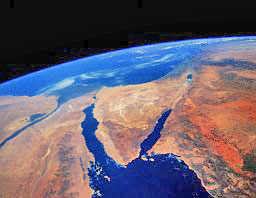|
Chapter Twelve
THE PYRAMIDS
OF GODS AND KINGS
"Somewhere in the vaults of the British Museum there is stashed away
a clay tablet which was found at Sippar, the "cult center" of
Shamash in Mesopotamia. It shows him seated on a throne, under a
canopy whose pillar is shaped as a date palm. A king and his son are
introduced to Shamash by another deity. In front of the seated god
there is mounted upon a pedestal a large emblem of a ray-emitting
planet. The inscriptions involve the god Sin (father of Shamash),
Shamash himself and his sister Ishtar.
"The theme of the scene - the introduction of kings or priests to a
major deity - is a familiar one, and poses no problems. What is
unique and puzzling in this depiction are the two gods (almost
superimposed upon one another) who, from somewhere outside of where
the introduction is taking place, hold (with two pair of hands) two
cords leading to the celestial emblem.
"Who are the two
Divine Cordholders? What is their function? Are
they identically situated, and if so, why do they hold or pull two
cords, and not just one? Where are they? What is their connection
with Shamash?
"Sippar, scholars know, was
the seat of the High Court of Sumer,
Shamash was consequently the ultimate lawgiver. Hammurabi, the
Babylonian king, famous for his law code, depicted himself receiving
the law from an enthroned Shamash. Was the scene with the two Divine Cordholders also connected with lawgiving? In spite of all the
speculation, no one so far has come up with an answer.
"The solution, we believe, has been available all along in the very
same British Museum - not among its "Assyrian" exhibits, however,
but in its Egyptian Department. In a room separate from the mummies
and the other remains of the dead and their tombs, there are
exhibited pages from the various papyri inscribed with the
Book of
the Dead. And the answer is right there, for all to see.
"It is a page from the "Papyrus of Queen Nejnet" and the drawing
illustrates the final stage of the Pharaoh’s journey in the Duat.
The twelve gods who pulled his barge through the subterranean
corridors have brought him into the last corridor, the Place of
Ascending. There, the "Red Eye of Horus" was waiting. Then, shed of
his earthly clothing, the Pharaoh was to ascend heavenward, his
Translation spelled out by the beetle hieroglyph ("Rebirth"). Gods
standing in two groups pray for his successful arrival at the
Imperishable Star.
"And unmistakably, there in the Egyptian depiction, are
two Divine Cordholders!
"....They are clearly located outside of the subterranean corridor.
Moreover, each side manned by a Cordholder is marked by an
omphalos
resting upon a platform. And, as the action imparted by the drawing
shows, the two divine aides are not simply holding the cords, but
are engaged in measuring.
"The discovery should not surprise: have not the verses of the
Book
of the Dead described how the journeying Pharaoh encounters the gods
"who hold the rope in the Duat," and the gods "who hold the
measuring cord"?
"A clue in the Book of Enoch now comes to mind. There, it will be
recalled, it is related that as he was taken by an angel to visit
the earthly paradise in the west, Enoch "saw in those days how long
cords were given to angels who took to themselves wings, and they
went towards the north." In reply to Enoch’s question, his guiding
angel explained: "They have gone off to measure... they shall bring
the measure of the Righteous to the Righteous... all these measures
shall reveal the secrets of the Earth."
"....The words of the
Prophet Habakuk thunder in ours ears...:
The Lord from South shall come,
The Holy One from Mount Paran.
Covered are the heavens with his halo,
His splendor fills the Earth,
His brilliance is like light.
His rays shine forth
from where his power is concealed.
The Word goes before him,
sparks emanate from below.
He pauses to measure the Earth.
He is seen, and the nations tremble.
"Was the measuring of Earth and its "secrets" then related to the
powered flight of the gods in Earth’s skies? The Ugaritic texts add
a clue as they tell us that, from the peak of Zaphon, Ba’al "a cord
strong and supple stretches out, heavenwards (and) to the Seat of Kadesh."
"Whenever these texts report a message from one god to another, the
verse begins with the word Hut. Scholars assume that it was a kind
of a calling prefix, a kind of "Are you ready to hear me?" But the
term could literally mean in the Semitic languages "cord, rope."
Scientifically, the term Hut in Egyptian also means "to extend, to
stretch out." Heinrich Brugsch, commenting on an Egyptian text
dealing with the battles of Horus (Die Sage von der geflugten
Sonnenscheibe) pointed out that Hut was also a place name - the
abode of the Winged Extenders, as well as the name of the
mountain
which Horus was imprisoned by Seth.
"....And then we have the depiction from
Sippar. It is not puzzling
if we recall that in the pre-Diluvial times, when Sumer was the
Land
of the Gods, Sippar was the Spaceport of the
Anunnaki, and Shamash
its Commander. Thus viewed, the role of the Divine Measurers will
become clear: their cords measured out the path to the Spaceport.
"....With the aid of photographs of Earth from spacecraft of the
U.S. National Aeronautics and Space Administration (NASA), we can view the
Near East as the Anunnaki had seen it from their own craft. What
vantage points could they choose from which to mark out a triangular
landing corridor? Close at hand, to the southeast, rose granite
peaks of southern Sinai. Amid the granite core rose the highest peak
(now called Mount St. Katherine). It could serve as a
natural beacon
to outline the southeastern line. But where was the counterpoint in
the northwest, on which the northern line of the triangle could be
anchored?
"Aboard the Shuttlecraft, the Surveyor - a "Divine Measurer" -
glanced at the earth panorama below, then studied his maps again. In
the far distance, beyond Baalbek, there loomed the twin-peaked
Ararat. He drew a straight line from Ararat through
Baalbek,
extending it all the way into Egypt.
"He took his compass. With
Baalbek as the focal point, he drew an
arc through the highest peak of the Sinai peninsula. Where it intersected the
Ararat-Baalbek line, he made a cross within
a circle. Then he drew two lines of equal length, one connecting
Baalbek with the peak in Sinai, the other with the site marked by
the cross.
"This he said, will be our triangular Landing Corridor, to lead us
straight to Baalbek.
’But sir, one of those
aboard said, there is nothing there, where you have made the
cross - nothing that can serve as a guiding beacon!’
’We
will have to erect there a pyramid, the commander said.’
"And they flew on, to report their decision.
 "Had such conversation indeed had taken place aboard a
shuttlecraft
of the Anunnaki? We, of course, shall never know (unless a tablet is
someday found recording the event); we have merely dramatized some
astounding but undeniable facts:
(click image right) "Had such conversation indeed had taken place aboard a
shuttlecraft
of the Anunnaki? We, of course, shall never know (unless a tablet is
someday found recording the event); we have merely dramatized some
astounding but undeniable facts:
(click image right)
*
The unique platform at Baalbek has been there from bygone days,
and it is still there intact in its enigmatic immensity.
*
Mount St. Katherine is still there, rising as the
highest peak of
the Sinai peninsula, hallowed since ancient days, enveloped
(together with the twin-peaked neighbour, Mount Mussa) in legends of
gods and angels.
* The
Great Pyramid of Giza, with its two companions and the unique
Sphinx, is situated precisely on the extended Ararat-Baalbek line,
and
* The distance from Baalbek to
Mount St. Katherine and to the Great
Pyramid of Giza is exactly the same.
|

Babylonian
Kings. Shalmanezer, above, meeting a Babylonian King.
At right, Hammurabi, receiving the Law from an enthroned
Shamash. |
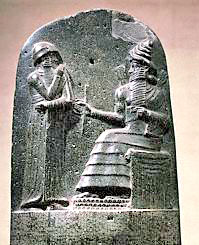 |
IN SEARCH FOR A
SPACEPORT
(click below image)
|
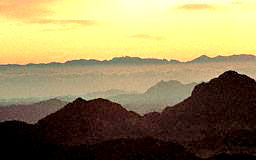
Mount
Katherine, the tallest in the Sinai group was also
chosen as a beacon, Egypt today. |

Fron
theirShuttlecraft, the astronauts from Nibiru, chose
Mount Ararat as a beacon.(Turkey today) |
|

The
Monastery
|
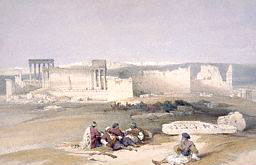
Baalbek was
chosen to build the platform for the SpacePort. Lebanon
today. |
|
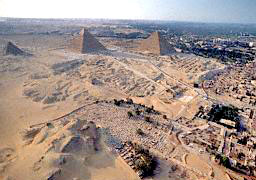
And to form
the perfect triangulation for the landing corridor, the
Pyramid(s) were built... the Great Sphinx.
Giza today, Egypt
|
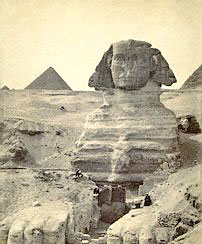
|
"This, let us add at
once, is only part of the amazing grid which - as we shall show -
was laid out by the Anunnaki in connection with their
post-Diluvial
Spaceport. Therefore, whether or not the conversation had taken
place aboard a shuttlecraft, we are pretty certain that that is how
the pyramids came to be in Egypt.
’There are many
pyramids and pyramidical structures in Egypt,
dotting the landscape from where the Nile breaks out into its delta
in the north, all the way south to (and into) Nubia.
"....These, in turn, consist of two distinct groups: the pyramids
clearly identified with rulers of the Fifth and Sixth Dynasties
(such as Unash, Teti, Pepi, which are elaborately decorated and
inscribed with the renowned Pyramid Texts; and the older pyramids
attributed to kings of the Third and Fourth Dynasties.
"....The texbooks will tell us that the first of Egypt’s imposing
pyramids was built by a king named Zoser, the second Pharaoh of the
Third Dynasty (circa 2650 B.C. by most counts). Selecting a site
west of Memphis, on the plateau that served as the necropolis (city
of the dead) of that ancient capital, he instructed his brilliant
scientist and architect named Imhotep to build him a tomb that would
surpass all previous tombs. Until then, the royal custom was to
carve out a tomb in the rocky ground, bury the king, and then cover
the grave with a giant horizontal tombstone called a mastaba that in
time grew to substantial dimensions. The ingenious Imhotep, some
scholars hold, covered the original mastaba over the tomb of
Zoser
with layer upon layer of ever smaller mastabas, in two phases,
achieving a step pyramid. Beside it, within a large rectangular
courtyard, a variety of functional and decorative buildings were
erected - chapels, funerary temples, storehouses, attendant’s
quarters and so on, the whole area was then surrounded by a
magnificent wall. The pyramids and the ruins of some of the
adjoining buildings and the wall can still be seen at Sakkara - a
name believed to have honored Seker, the "hidden God."
Presumably it was Sekhemkhet, who followed
Zoser on the throne, who
began to build the second step pyramid, also at Sakkara. It never
really got off the ground, for reasons unknown (perhaps the missing
ingredient was the enigmatic genius of science and engineering,
Imhotep). A third step pyramid.... it is logically attributed by
some scholars to the next Pharaoh on the throne, named Khaba.
"....In the absence of evidence (of other Pharaohs) the next in line
was Huni. Through much circumstantial evidence, it is held however
that he only commenced the construction, and that the attempt to
complete the pyramid was undertaken by his successor Sneferu.
This pyramid, according to the texts was a true-pyramid, but was a
failure, the outer walls collapsed and "all that remains of that
attempt is part of the solid core, with a large mound of debris all
around it.
However Sneferu ordered two more pyramids, the Bent Pyramid, called
so because the builders changed the pyramid’s angle in mid
construction, this pyramid still stands. And the Red Pyramid, due to
the hue of its stones, rises as a triangle from a square base, by
changing the perfect inclination of 52 degrees to that of 44
degrees.
"....Sneferu was the father of Khufu (whom Greek historians called
Cheops); it has thus been assumed that the son followed the
achievement of his father by building the next true pyramid - only a
larger and grander one: the Great Pyramid of Giza. It stands
majestically as it has stood for millennia in the company of two
other major pyramids, attributed to his successors Chefra (Chephren)
and Menka-ra (Mycerinus); they three are surrounded by smaller
satellite pyramids, temples, mastabas, tombs and the unique Sphinx.
Though attributed to different rulers, the three obviously were
planned and executed as a cohesive group , perfectly aligned not
only to the cardinal points of the compass but also with one
another. Indeed, triangulations which begin with these three
monuments can be extended to measure the whole of Egypt - the
whole
of Earth, for that matter. This was first realized in modern times
by Napoleon’s engineers: they selected the apex of the Great Pyramid
as the focal point from which they triangulated and mapped Lower
Egypt.
"This was made even easier by the discovery that the site is
located, for all intent and purposes, right on the thirtieth
parallel (north). The whole Giza complex of massive monuments had
been erected at the eastern edge of the Lybian Plateau, which begins
in Lybia in the west and stretches to the very banks of the
Nile.
Though only some 150 feet above the river’s valley below, the Giza
site has a commanding and unobstructed view to the four horizons.
The Great Pyramid stands at the extreme northeastern edge of a
protrusion of the plateau, a few hundred feet to the north and
east, sands and mud begin, making such massive structures
impossible.
"....The alignment with the cardinal points of the compass, the
inclination of the sides at the perfect angle of about 52 degrees
(at which the height of the pyramid in relation to its circumference
is the same as that of a radius of a circle to its circumference);
the square bases, set on perfectly level platforms - all bespeak of
a high degree of scientific knowledge of mathematics, astronomy,
geometry, geography and of course building and architecture, as well
as the administrative ability to mobilize the necessary manpower, to
plan and execute such massive and long-term projects. The wonderment
only increases as one realizes the interior complexities and
precision of the galleries, corridors, chambers, shafts and openings
that have been engineered within the pyramids, their hidden
entrances (always on the north face), the locking and plugging
systems - all unseen from the outside, all in perfect alignment with
each other, all executed within these artificial mountains as they
were being built layer after layer.
"....On ground that has been artificially leveled, the
Great Pyramid
rises on a thin platform whose four corners are marked by sockets of
no ascertained function. In spite of the passage of millennia,
continental shifts, Earth’s wobble around its own axis, earthquake
and the immense weight of the pyramid itself, the relatively thin
platform (less that twenty-two inches thick) is still undamaged and
perfectly level.
"....From a distance, the Great Pyramid and its two companions
appear to be true pyramids; but when approached it is realized that
they too are a kind of step pyramid, built layer upon layer
(scholars call them courses) of stone, each layer smaller than the
one below it.) of stone
"....What gave it the smooth, inclined sides were the casing stones
with which its sides were covered. These have been removed in Arab
times and used for the constructions of nearby Cairo, but a few can
still be seen in position near the top of the Second Pyramid....
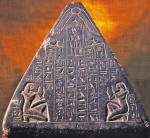 "....The
Giza pyramids are nowadays also minus their apex or
capstones which were shaped as pyramidions and may have been either
made of metal or covered with a shiny metal - as the similar
pyramidion-shaped tips of obelisks were. Who, when and why they were
removed from their great heights, no one knows. It is known however
that in later times these apex stones, resembling the Ben-Ben at
Heliopolis
(click image left) were made of special granite and bore appropriate
inscriptions. The one from the pyramid "....The
Giza pyramids are nowadays also minus their apex or
capstones which were shaped as pyramidions and may have been either
made of metal or covered with a shiny metal - as the similar
pyramidion-shaped tips of obelisks were. Who, when and why they were
removed from their great heights, no one knows. It is known however
that in later times these apex stones, resembling the Ben-Ben at
Heliopolis
(click image left) were made of special granite and bore appropriate
inscriptions. The one from the pyramid
 of
Amen-emkhet at Dahshur,
which was found buried some distance away from the pyramid, bore the
emblem of the Winged Globe and the inscription
(click image right) of
Amen-emkhet at Dahshur,
which was found buried some distance away from the pyramid, bore the
emblem of the Winged Globe and the inscription
(click image right)
The face of king Amen-em-khet is opened,
That he may behold the Lord of the Mountain of Light
When he sails across the sky.
"When Herodotus visited
Giza in the fifth century, the capstones are
not mentioned, but the pyramids’ sides were still covered with the
smooth facings.... It was Herodotus who transmitted the information
that the Pharaoh who ordered the Pyramid built was Cheops (Khufu),
why and what for, he does not say. Herodotus likewise attributed the
Second Pyramid to Chephren (Chefra), "of the same dimensions, except
that he lowered the height forty feet," and asserted that Mycerinus
(Menkara) "too left a pyramid, but much inferior in size to his
father’s - implying but not actually stating, that it was the Third
Pyramid of Giza.
|
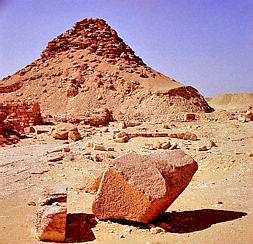
Remains of
ruins of Teti’s Pyramid, Saqqarah, Egypt.
|

PEPI |
|
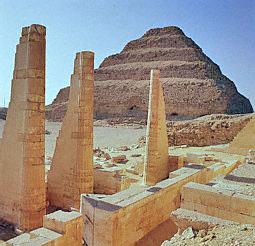
Zoser’s Step
Pyramid, Saqqarah, Egypt
|

Sculpture in
Step Pyramid Complex of Zoser, designed by Imhotep.
Saqqarah, Egypt. |
|
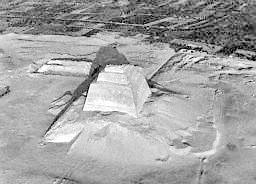
Pyramid
began under Huni and finished under Sneferu. The
structure colapsed in ancient times. Burial complex lies
to the left of the Pyramid. |
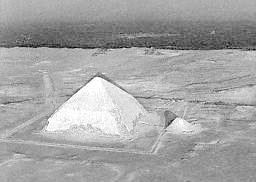
Bent Pyramid
at Dahshur. Built for Sneferu. A Small Pyramid for the
Queen of Sneferu lies to the right of the Pyramid.
|
|
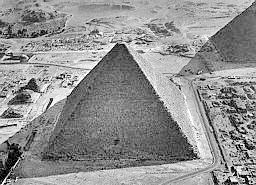
Pyramid of
Khufu (Cheops), Sneferu’s son.
The Great Pyramid of Giza..
Mastabas and other mortuary structures surround the
Pyramid. |
|
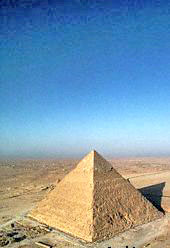
Chephren’s
Pyramid at Giza. A Pharaoh of the Old Kingdom, photo
taken from atop of Cheops Pyramid. |
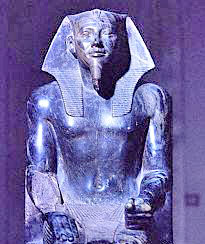
Chephren’s
sculpture
. |
|
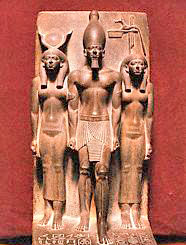
Mycerinus’ (Menkara)
Triad: with Goddess Hathor to his right and goddess Hare
Nome to his left. |
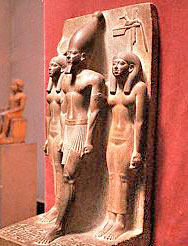
|
"In the first century
A.D., the Roman geographer and cartographer Strabo recorded not only
a visit to the pyramids, but also his entry to the Great Pyramid
through an opening in the north face, hidden by a hinged stone.
Going down a long and narrow passage, he reached a pit dug in the
bedrock - as other Greek and Roman tourists had done before him.
"The location of this entryway was forgotten in the following
centuries, and when the Moslem caliph Al Mamoon attempted to enter
the pyramid in 820 A.D., he employed an army of masons, blacksmiths
and engineers to pierce the stone and tunnel his way into the
pyramid’s core.
"....Blasting through the mass of stones by heating and cooling them
until they cracked, by ramming and chiseling, Al Mamoon’s men
advanced into the pyramid inch by inch.
They were about to give up, when they heard the sound of a falling
stone not far ahead, indicating that some cavity was located there.
With renewed vigor, they blasted their way into the original
Descending Passage. Climbing up it they reached the original
entrance which had evaded them from the outside. Climbing down, they
reached the pit described by Strabo, it was empty. A shaft from the
pit led nowhere.
"....But Fate wished otherwise. The ramming and blasting by
Al Mamoon’s men had loosened the stone, whose falling sound had
encouraged them to tunnel on. As they were about to give up, the
fallen stone was found lying in the Descending Passage. It had an
odd, triangular shape. When the ceiling was examined it was found
that the stone served to hide from view a large rectangular granite
slab positioned at an angle to the Descending Passage. Did it hide
the way to a really secret chamber - one obviously never before
visited?
"Unable to move or brake the granite block, Al Mamoon’s men tunneled
around it. It turned out that the granite slab was only one of a
series of massive granite blocks, followed by limestone ones, that
plugged an Ascending Passage - inclined upward at the same 26 degree
angle that the Descending Passage was inclined downward (precisely
half the angle of the pyramid’s outer inclination). From the top of
the Ascending Passage, a horizontal passage led to a squarish room
with a gabled roof and an unusual niche on its east wall; it was
bare and empty. This chamber has since been found to lie precisely
in the middle of the north-south axis of the pyramid - a fact whose
significance has not yet been deciphered. The chamber has come to be
known as the "Queen’s Chamber"; but the name is based on romantic
notions and not on any shred of evidence.
"At the head of the
Ascending Passage, there extended for 150 feet
and at the same rising angle of 26 degrees a Grand Gallery of
intricate and precise construction. Its sunken floor is flanked by
two ramps that run the length of the Gallery; in each ramp there are
cut a series of evenly spaced rectangular slots, facing each other.
The Gallery’s walls rise more than 18 feet in seven corbels, each
section extending three inches out above the lower one, so that the
Gallery narrows as it rises. At its top, the Gallery’s ceiling is
the exact width as the sunken floor between the ramps.
"At the uppermost end of the Gallery, a huge stone formed a
platform. Flush with it a short and comparatively narrow and low
corridor (only 3.5 feet high) led to an ante-chamber of extremely
complex construction, having been equipped to lower with a simple
maneuver (the pull of a rope?) three solid granite walls that could
vertically plug the passage and block further advance.
"A short corridor, of a height and width similar to the former one
then led to a high-ceilinged room constructed of red polished
granite - the so called King’s Chamber. It was empty except for a
granite block hewed out to suggest a lidless coffer. Its precise
workmanship included grooves for a lid or top section. Its
measurements, as has since been determined, exhibited knowledge of
profound mathematical formulas. But it was found totally empty.
"Was this whole mountain of stone, then, erected to hide an empty
"coffer" in an empty chamber? Blackened torch marks and the evidence
of Strabo attest that the Descending Passage was visited before; if
there had ever been treasure in that subterranean room, it was
removed long ago. But the Ascending Passage was most definitely
blocked tight when Al Mamoon’s men reached it in the ninth century
A.D. The theory of the pyramids as royal tombs held that they were
raised to protect the Pharaoh’s mummy and the treasures buried with
it from robbers and other uninvited disturbers of his eternal peace.
Accordingly, the plugging of the passages is presumed to have taken
place as soon as the mummy in its coffin was placed in the burial
chamber. Yet there was a plugged passage - with absolutely nothing,
except for an empty stone coffer, in the whole pyramid.
"In time, other rulers, scientists, adventurers have entered the
pyramid, tunneled and blasted through it, discovering other features
of its inner structure - including two sets of shafts which some
believe were air ducts (for whom?) and others assert for
astronomical observations (by whom?). Although scholars persist in
referring to the stone coffer as a sarcophagus (its size could well
hold a human body), the fact is that there is nothing, absolutely
nothing to support a claim that the Great Pyramid was a royal tomb.
"Indeed the notion that the pyramids were built as Pharaonic tombs
has remained unsupported by concrete evidence.
Of Zoser’s Pyramid,
Mr. Sitchin explains about other mummies found
in later centuries:
"....It is now generally accepted that all these extra mummies
(found in Zoser’s Pyramid) and coffins represent intrusive burials,
mainly the entombment of the dead from a later time by intruding on
the sanctity of the sealed galleries and chambers. But was Zoser
himself ever entombed in the pyramid - was there ever an "original
burial?"
"....Many eminent Egyptologists now believe that the pyramid was
only a symbolic burial place for Zoser, and that the king was buried
in the richly decorated Southern Tomb, topped by a large rectangular
superstructure with a concave room which also contained the
imperative chapel - just as depicted in some Egyptian drawings.
"The step pyramid to have been begun by Zoser’s successor,
Sekhemkhet, also contained a "burial chamber." It housed an
alabaster "sarcophagus," which was empty. Textbooks tell that the
archaeologist who discovered the chamber and the stone coffer (Zakaria
Goneim) concluded that the chamber had been penetrated by grave
robbers, who stole the mummy and all other contents of the tomb; but
that is not entirely true. In fact, Mr. Goneim found the vertically
sliding door of the alabaster coffer shut and sealed with plaster,
and the remains of a dried-out wreath still rested on top of the
coffin. As he later recalled, "hopes were now raised to a high
pitch: but when the sarcophagus was opened, it was found to be empty
and unused." Had any king been buried there? While some still say
yes, others are convinced that the pyramid of Sekhemkhet (jar
stoppers bearing his name attest to the identification) was only a
cenotaph (an empty, symbolic tomb).
"The third step pyramid, the one attributed to
Khaba, also contained
a "burial chamber"; it was found to be completely bare: no mummy,
not even a sarcophagus. Archaeologists have identified in the same
vicinity the subterranean remains of yet another, unfinished pyramid
believed to have been begun by Khaba’s successor. Its granite
substructure contained an unusual oval "sarcophagus" sunken into the
stone floor (as an ultra-modern bathtub). Its lid was still in
place, shut tight with cement. There was nothing inside.
"....The next two
pyramids are even more embarrassing to the pyramids-as-tombs theory.
The two pyramids at Dahshur (the Bent and the
Red) were both built
by Sneferu. The first has two "burial chambers," the other three.
All for Sneferu? If the pyramid was built by each Pharaoh to serve
as his tomb, why did Sneferu build two pyramids? Needless to say,
the chambers were totally empty when discovered, devoid even of
sarcophagi. After some more determined excavations by the Egyptian
Antiquities Service in 1947 and again in 1953 (especially in the Red
Pyramid) the report admitted that "No trace of a royal tomb has been
found there."
And so continues this most interesting chapter.
Mr. Sitchin mentions
numerous successors, finding nothing in the sarcophagus when
discovered, and the repeated findings of later mummies by intrusion.
The graphics on the book, of the structures of the pyramids are a
great aid to understand the enigmatic complexity of these standing
monuments.
Mr. Sitchin thus concludes this chapter:
"Where were the Sixth Dynasty kings really buried? The royal tombs
of that dynasty and of earlier ones were all the way south, at
Abydos. This, as the other evidence, should have completely
dispelled the notion that the tombs were cenotaphs and the pyramids
the real tombs; nevertheless, long held beliefs die hard.
"The facts bespeak the opposite. The
Old Kingdom pyramids never held
a Pharaoh’s body because they were never meant to hold a king’s
body. In the Pharaoh’s simulated journey to the Horizon, they were
built as beacons to guide his ka to the Stairway to Heaven -
just as
the pyramids originally raised by gods had served as beacons for the
gods when they "sailed across the sky."
"Pharaoh after Pharaoh, we suggest attempted to emulate not the
pyramid of Zoser, but the Pyramids of the Gods: the pyramids at
Giza.
Return
Chapter Thirteen
FORGING THE
PHARAOH’S NAME
"Forgery as a means to fame and fortune is not
uncommon in commerce
and the arts, in science and antiquities. When exposed, it may cause
loss and shame. When sustained, it may change the records of
history.
"This, we believe, has happened to the Great Pyramid and its
presumed builder, the Pharaoh named Khufu.
"Systematic and disciplined archaeological re-examination of pyramid
sites that were hurriedly excavated a century and a half ago (many
times by treasure hunters), has raised numerous questions regarding
some of the earlier conclusions. It has been held that the Pyramid
Age began with Zoser’s step pyramid and was marked by successive
progression toward a true pyramid, which finally succeeded. But why
was it so important to achieve a true pyramid? If the art of pyramid
building was progressively improved, why were the many pyramids
which followed the Giza pyramids inferior, rather than superior to
those of Giza?
"Was Zoser’s step pyramid the model for others, or was it itself an
emulation of an earlier model? Scholars now believe that the first,
smaller step pyramid that Imhotep built over the mastaba "was cased
with beautiful, fine white limestone" (Ahmed Fakhry, The Pyramids),
"before this casing was complete, however, he planned another
alteration" - the superimposition of an even larger pyramid.
However, as new evidence suggests, even that final step pyramid was
cased, to look like a true pyramid. The casing uncovered by
archaeological missions of Harvard University led by George Reisner,
was primitively made of mud bricks, which of course crumbled soon
enough - leaving the impression that Zoser built a step pyramid.
Moreover, these mud bricks, it was found, were whitewashed to
simulate a casing of white limestone.
"Whom then was Zoser trying to emulate? Where had
Imhotep seen a
true pyramid already up and complete, smooth side and limestone
casing and all? And another question: If, as the present theory
holds, the attempts at Maidum and Sakkara to build a smooth, 52
degree pyramid had failed, and Sneferu had to "cheat" and build the
presumed first true pyramid at an angle of only 43 degree - why did
his son at once proceed to build a much larger pyramid at the
precarious 52 degree - and supposedly managed to achieve that with no
problem at all?
"If the pyramids at Giza were only "usual" pyramids in the
successive chain of pyramid-per-Pharaoh - why did Khufu’s son
Radedef not build his pyramid next to his father’s at
Giza? Remember
- the other two Giza pyramids were supposedly not be there yet, so
Radedef had the whole site free to build as he pleased. And if his
father’s architects and engineers mastered the art of building the
Great Pyramid, where were they to help Radedef build a similar
imposing pyramid, rather than the inferior and quickly crumbling one
that bears his name?
"Was the reason that no other pyramid but the Great Pyramid
possessed an Ascending Passage, that its unique Ascending Passage
was successfully blocked until A.D. 820 - so that all who emulated
this pyramid knew of a Descending Passage only?
"The
absence of hieroglyphic inscriptions in the three pyramids of Giza is also a reason for wondering, as
James Bonwick did a century
ago (Pyramid Facts and Fancies):
"Who can persuade himself that the
Egyptians would have left such superb monuments without at least hieroglyphical inscriptions - they who were profuse of hieroglyphics
upon all the edifices of any consideration?"
The absence, one must
surmise, stems from the fact that the pyramids had either:
"These are some of the points that strengthen our belief that when
Zoser and his successors began the custom of pyramid building, they
set out to emulate the models that had already existed: the
pyramids
of Giza. They were not improvements on Zoser’s earlier efforts;
rather, they were prototypes which Zoser, and Pharaohs after him,
attempted to emulate.
"Some scholars have suggested that the
small satellite pyramids at Giza were really scale models (about 1.5) that were used by the
ancients exactly as today’s architects use scale models for
evaluation and guidance, but it is now known that they were later
augmentations. However, we think that there was indeed such a scale
model; the Third Pyramid, with its obvious structural experiments.
Then, we believe, the larger two were built as a pair of guiding
beacons for the Anunnaki.
"But what about
Menkara, Chefra and Khufu, who (we have been told by
Herodotus) were the builders of these pyramids?
"Well indeed - what about them? The temples and causeway attached to
the Third Pyramid do bear evidence that their builder was Menkara -
evidence that includes inscriptions bearing his name and several
exquisite statues showing him embraced by Hathor and another
goddess. But all that this attests to is that Menkara built these
auxiliary structures, associating himself with the pyramid - not
that he built it. The Anunnaki, it is logical to assume, needed only
the pyramids - and would not have built temples to worship
themselves, only a Pharaoh required a funerary temple and a mortuary
temple and the other structures associated with his journey to the
gods.
"Inside the Third Pyramid proper, not an inscription, not a statue,
not a decorated wall have been found; just stark, austere
precision."
There were artifacts and mummies found with
Menkara’s name, but when
analyzed, these showed to be false pretenses.
"The Second Pyramid is likewise completely bare. There is nothing at
all to indicate that Chefra built it.
"What then about
Khufu?
"With one exception, which we will expose as a probable forgery, the
only claim that he built the Great Pyramid is reported by
Herodotus
(and, based on his writings, by a Roman historian) Herodotus
described him as a ruler who employed his people for thirty years to
build the causeway and the pyramid. Yet by every other account, Khufu reigned for only
twenty-three years. If he were such a
grandiose builder, blessed with the greatest of architects and
masons, where are his other monuments, where are his
bigger-than-life statues?
"There are none, and it would seem from the absence of such
commemorative remains, that Khufu was a very poor builder, not a
majestic one."
And so it is found that in reviewing the different
Pharaohs, they
had built their temples, satellite buildings, and causeways,
surrounding the pyramids of Giza already in existence.
Therefore:
"With the ready-made pyramids thus taken, the
Pharaohs who followed
were forced to obtain pyramids the hard way: by trying to build
them.... As those who had tried this before (Zoser, Sneferu,
Radedef),
their own efforts too ended with inferior emulations of the three
olden pyramids.
"At first blush, our suggestion that Khufu (as the other two) had
nothing to do with building the pyramid associated with him may
sound very farfetched. It is hardly so. In evidence, we call upon
Khufu himself.
"Whether Khufu had really built the
Great Pyramid was a question
that began to perplex serious Egyptologists more than a century and
a quarter ago, when the only object mentioning Khufu and connecting
him with the pyramid was discovered. Puzzlingly, it affirmed that he
had not built it: it already existed when he reigned!
"The damning evidence is a limestone
stela which was discovered by
Auguste Mariette in the 1850s in the ruins of the temple of Isis,
near the Great Pyramid. Its inscription identifies it as a
self-laudatory monument by Khufu, erected to commemorate the
restoration by him of the temple of Isis and of images and emblems
of the gods which Khufu found inside the crumbling temple. The
opening verses unmistakably identify Khufu by his cartouche.
"The common opening, invoking
Horus and proclaiming long life for
the king, then packs explosive statements:
He founded.... the House.... of Isis....
Mistress of the pyramid....
beside the House of the Sphinx....
"According to the inscription on this
stela (which is in the Cairo
Museum), the Great Pyramid was already standing when Khufu arrived
on the scene. Its mistress was the goddess Isis - it belonged to
this goddess and not to Khufu.
|
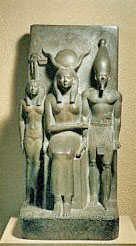
Goddess
Hathor (center),Mycerinus (Menkara) and Goddess Hare
Nome. |
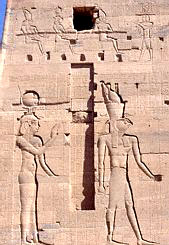
Goddess
Hathor
and Horus
|
"Furthermore, the
Sphinx
too - which has been attributed to Chefra, who presumably built it
together with the Second Pyramid - was also already crouching at its
present location.
The continuation of the inscription pinpoints the position of the
Sphinx accurately, and records the fact that part of it was
damaged
by lightning - a damage perceivable to this very day.
"....The "Inventory Stela," as it came to be called, bears all the
marks of authenticity. Yet scholars at the time of its discovery
(and many ever since) have been unable to reconcile themselves to
its unavoidable conclusions.
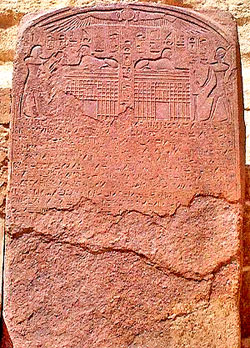 Unwilling to upset the whole structure of
Pyramidology, they
proclaimed the Inventory Stela a forgery - an inscription made "long
after the death of Khufu" (to quote Selim Hassan,
Excavations at Giza), but invoking his name "to support some
fictitious claim of
the local priests." Unwilling to upset the whole structure of
Pyramidology, they
proclaimed the Inventory Stela a forgery - an inscription made "long
after the death of Khufu" (to quote Selim Hassan,
Excavations at Giza), but invoking his name "to support some
fictitious claim of
the local priests."
Other Egyptologists however, gave credit to the
Inventory Stela
(click image right)
"and Maspero (Gaston) accepted the contents of the
Stela as factual
data concerning the life and activities of Khufu."
"Why then the reluctance to call the artifact authentic?
"The Inventory Stela was condemned as a forgery because only a
decade or so earlier the identification of Khufu as the builder of
the Great Pyramid appeared to have been indisputably established.
The seemingly conclusive evidence was markings in red paint,
discovered in sealed chambers above the King’s Chamber, which could
be interpreted as mason’s markings made in the eighteenth year of
the reign of Khufu. Since the chambers were not entered until
discovered in 1837, the markings must have been authentic; and if
the Inventory Stela offered contradictory information,
the Stela
must have been a forgery.
"But as we probe the circumstances of the red-paint markings and
ascertain whose the discoveres were - an inquiry somehow never
undertaken before - the conclusion that emerges is this: if a
forgery had taken place, it occurred not in ancient times, but in the
year A.D.1837, and the forgers were not "some local priests" but two
(or three) unscrupulous Englishmen....
"The story begins with the arrival in Egypt on December 29, 1835 of
Colonel Richard Howard Vyse, a "black sheep" of an aristocratic
English family....
He was especially thrilled by the tales and theories of one Giovanni
Battista Caviglia, who had been searching for a hidden chamber
inside the Great Pyramid.... Caviglia rejected to have Vyse as
co-discoverer....
Vyse had befriended a crafty go-between by the name J.R. Hill, then
a copper mill superintendent. Now he was introduced to a "Mr.
Sloane," who whispered that there were ways to get a Firman - a
concession decree - from the Egyptian Government to sole excavations
rights at Giza."
Vyse did not get the rights. But
Sloane and Col. Campbell, the
British Consul did, with Caviglia as work’s supervisor.
"But instead of searching for the hidden chamber,
Caviglia and his
workmen were busy digging up mummies from tombs around the pyramids.
"The excavations at the tombs showed that the ancient masons
sometimes marked the pre-cut stones with red paint. Such markings,
Caviglia said, he found at the base of the Second Pyramid, but when
examined with Vyse, the "red paint" turned out to be natural
discolorations in the stone.
"What about the Great Pyramid?
Caviglia, working there to discover
where the "air channels" were leading from the "King’s Chamber," was
more than ever convinced that there were hidden secrets chambers
higher up. One such compartment, reachable via a crawlway, was
discovered by Nathaniel Davison in 1765.
Caviglia however, was more interested in searching for mummies,
which every museum then desired.
"....On February 11, the two had a violent argument. On the twelfth,
Caviglia made major discoveries on Campbell’s Tomb (named by
Caviglia): a sarcophagus inscribed with hieroglyphics and masons’
red-paint markings on the stone walls of the tomb. On the
thirteenth....
Caviglia was discharged and ordered away from the site.
Caviglia
returned for his belongings. He made many "dishonorable accusations"
against Vyse.
"Was the row a genuine disagreement, or did
Vyse artificially bring
matters to a head to get Caviglia off the site?
Plots followed, dismissals, new men coming and going from and to the
works. Mr. Sitchin gives a detailed story of all the dealings of
these men.
Hidden Chambers were discovered in the pyramid, but as usual they
were all empty. When Vyse was satisfied:
"His work was done, he found hitherto unknown chambers, and he
proved the identity of the builder of the Great Pyramid, for within
the cartouches (found) was written the royal name Kh-u-f-u.
"To this discovery, every textbook has been attesting to this very
day.
"The impact of Vyse’s discoveries was great, and their acceptance
assured, that he managed to quickly obtain a confirmation from the
experts of the British Museum in London.
"When the facsimiles made by
Mr. Hill reached the Museum, and when
their analysis reached Vyse, is not clear, but he made the Museum’s
opinion (by the hand of its hieroglyphics expert Samuel Birch) part
of his chronicle of May 27, 1837. On the face of it, the long
analysis confirmed Vyse’s expectations: the names in the cartouches
could be real as Khufu or variations thereof: just as Herodotus had
written, Cheops was the builder of the Great Pyramid.
"But in the excitement which understandably followed, little
attention was paid to the many if’s and but’s in the Museum’s
opinion. It also contained the clue that tipped us off to the
forgery: the forger’s clumsy mistake.
"To begin with,
Mr. Birch was uneasy about the orthography and
script of the many markings. "The symbols or hieroglyphs traced in
red by the sculptor, or mason, upon the stones in the chambers of
the Great Pyramid are apparently quarry marks," he observed in his
opening paragraph; the qualification at once followed: "Although not
very legible, owing to their having been written in semi-hieratic or
linear-hieroglyphic characters, they possess points of considerable
interest...."
"What puzzled Mr. Birch was that markings presumably from the
beginning of the Fourth Dynasty were made in a script that started
to appear only centuries later. Originating as pictographs -
"written pictures" - the writing of hieroglyphic symbols required
great skill and long training, so, in time, in commercial
transactions, a more quickly written and simpler, more linear script
referred to as hieratic came into use. The hieroglyphic symbols
discovered by Vyse thus belonged to another period. They were also
very indistinct and Mr. Birch had great difficulty in reading them:
"The meaning of the hieroglyphics following the prenomen in the same
linear hand as the cartouche, is not very obvious ....The symbols
following the name are very indistinct."
Many of them looked to him
"written in characters very nearly hieratic" -
from an even much
later period that the semi-hieratic characters. Some of the symbols
were very unusual, never seen in any other inscription in Egypt:
"The cartouche of
Suphis" (Cheops), he wrote, "is followed by a
hieroglyphic which it would be difficult to find a parallel." Other
symbols were "equally difficult of solution."
"Mr. Birch was also puzzled by "a curious sequence of symbols" in
the upper-most, vaulted chamber (named by Vyse "Campbell’s
Chamber"). There, the hieroglyphic symbol for "good, gracious" was
used as a numeral - a usage never discovered before or since. Those
unusually written numerals were assumed to mean "eighteenth year"
(of Khufu’s reign).
"....Whoever daubed the red-paint markings reported by
Vyse had thus
employed a writing method (linear), scripts (semi-hieratic and
hieratic) and titles from various periods - but none from the time
of Khufu, and all from later periods. Their writer was also not too
literate: many of his hieroglyphics were either unclear, incomplete,
out of place, erroneously employed or completely unknown.
Turning to the main issue on which he was requested to give an
opinion - the identity of the Pharaoh named in the inscriptions -
Birch threw a bombshell: there were two and not just one, royal
names within the pyramid!
"Was it possible that two kings had built the same pyramid? And if
so, who were they?
"One cartouche was then read Saufou or
Shoufou; the other included
the ram symbol of the Khnum and was then read Senekhuf or
Seneshoufou.
After some considerations:
"....Conceding that the two names could have stood for what the
ancient
King Lists had called Suphis I (Cheops) and Suphis II (Chephren),
Birch tried to resolve the problem by wondering whether both names,
somehow, belonged to Cheops alone - one as his actual name, the
other as his "prenomen." But his final conclusion was that "the
presence of this (second) name, as a quarry-mark in the Great
Pyramid, is an additional embarrassment" on top of the other
embarrassing features of the inscriptions.
"....England’s most noted Egyptologist,
Flinders Petrie, spent
months measuring the pyramids a half century later. "The most
destructive theory about this king (Khnem-khuf) (as it is nowadays
read) is that he is identical with Khufu." Petrie wrote in
The
Pyramids and Temples of Gizeh, giving the many reasons voiced by
then by other Egyptologists against such a theory. For any number of
reasons, Petrie showed, the two names belonged to separate kings.
Why then did both names appeared within the Great Pyramid in the
locations in which they did? Petrie believed that the only plausible
explanation would be that Cheops and Chephren were co-regents,
reigning together.
"Since no evidence to support Petrie’s theory has been found,
Gaston Maspero wrote almost a century after the discovery by
Vyse that "the
existence of the two cartouches Khufui and Khnem-Khufui on the same
monuments has caused much embarrassment to Egyptologists" (The Dawn
of Civilization). The problem, in spite of all suggested solutions,
is still and embarrassing one.
"But a solution, we believe, can be offered - if we stop attributing
the inscriptions to ancient masons, and begin to look at the facts.
"The pyramids of Giza are unique, among other things, for the
complete absence of any decoration or inscriptions within them -
with the outstanding exception of the inscriptions found by Vyse.
Why the exception? If the masons felt no qualms about daubing in red
paint inscriptions upon the blocks of stone hidden away in the
compartments above the "King’s Chamber" why were there absolutely no
such inscriptions found in the first compartments, the one
discovered by Davison in 1765 - but only in the compartments found
by Vyse?
"....The cartouches and royal titles daubed upon the walls of the
compartments were imprecise, crude and extra large.... They are in
sharp contrast to the precision and delicacy and perfect sense of
proportion of ancient Egyptian hieroglyphics, evident in the true
masons’ markings found in those same compartments.
After some more comparisons,
Mr. Sitchin continues:
"....In other words: cannot all the puzzles be solved, if we assume
that the inscriptions were not made in antiquity, when the pyramid
was being built, but only after Vyse had blasted his way into the
compartment?
"....We know from Vyse’s chronicles that, by day, he had sent in
Mr.
Hill to inscribe the chambers with the name of the Duke of
Wellington and Admiral Nelson, heroes of the victories over
Napoleon. By night, we suspect, Mr. Hill also entered the chambers-
to "christen" the pyramid with the cartouches of its presumed
ancient builder.
"....Having looked up Wilkinson’s
Materia Hieroglyphica (the one and
only book repeatedly mentioned in Vyse’s chronicles, (Sir)
John
Gardner Wilkinson), we can sympathize with Vyse and Hill: its text
and presentation are disorganized, and its plates reproducing
cartouches are small, ill-copied and badly printed. Wilkinson
appears to have been uncertain not only regarding the reading of
royal names, but also regarding the correct manner by which
hieroglyphs carved or sculptured on stone should be transcribed in
linear writing. The problem was most acute concerning the disk
sign, which on such monuments appeared as either a solid disk, or as
a void sphere, and in linear (or brushed-of) writing as a circle
with a dot in its center. In his works, he transcribed the royal
cartouches in question in some instances as a solid disk, and in
others as a circle with a dot in the center.
Mr. Sitchin’s research in this matter of
authenticity of forgery
does not end here. Several more pages are dedicated on his book
regarding the doings of Vyse-Hill-Perry and others, but in
conclusion to this chapter he continues:
"(While most Egyptologists have accepted without further
investigation the claim that Khufu’s name was inscribed in the
Great
Pyramid, the works of Sir Alan Gardiner suggest that he had doubts
on the subject. In his Egypt of the Pharaohs, he reproduced royal
cartouches with a clear distinction between the hieroglyphs of Ra
and Kh. The cartouche of Cheops, he wrote, "is found in various
quarries, in the tombs of his kinfolk and nobles, and in certain
writing of later date." Conspicuous by its absence in this list is
the inscription in the Great Pyramid.... Also omitted by Sir Alan
were any mention of Vyse’s discoveries in the Third Pyramid and even
of Vyse’s name as such)."
"If the proof of the construction of the
Giza pyramids by the
presumed Pharaohs stands shattered, there is no longer reason to
suspect the authenticity of the Inventory Stela, which stated that
the pyramids and the Sphinx were already there when Khufu came to
pay homage to Isis and Osiris.
"There is nothing left to contradict our contention that these three
pyramids were built by the "gods." On the contrary: everything about
them suggests that they were not conceived by men for men’s use.
"We shall proceed to show how they were part of the Guidance Grid
that served the Spaceport of the Nefilim."
Return
Chapter Fourteen
THE GAZE OF
THE SPHINX
"In time, the
pyramids of Giza were made part of the Landing Grid
which had the peaks of Ararat as its focal point, incorporated
Jerusalem as a Mission Control Center, and guided the space vehicles
to the Spaceport in the Sinai peninsula.
"But at first, the pyramids themselves had to serve as guiding
beacons, simply by virtue of their location, alignment and shape.
All Pyramids, as we have seen, were at their core step pyramids -
emulating the ziggurats of Mesopotamia. But when the "gods who came
from heaven" experimented with their scale model at
Giza (the Third
Pyramid), they may have found that the silhouette of the ziggurat
and the shadow it cast upon the undulating rocks and ever-shifting
sands were too blurred and inaccurate to serve as a reliable
Pointer-of- the-Way. By casing the stepped core to achieve a "true"
pyramid, and using white (light-reflecting) limestone for the
casing, a perfect play of light and shadow was achieved, providing
clear orientation.
"....In 1882, Robert Ballard, in
The Solution of the Pyramid
Problem, he also showed that the pyramids were aligned with each
other in the basic Pythagorean right-angled triangles, whose sides
were proportionate to each other as 3.4.5. Pyramidologists have also
noticed that the shadows cast by the pyramids could serve as a
giant
sundial, the direction and length of the shadows indicating time of
year and of day.
"Even more important, however, was how the silhouettes and shadows
of the pyramids appeared to an observer from the skies.... the true
shape of the pyramids casts arrowlike shadows, which were as
unmistakable direction pointers.
"When all was ready to establish a proper
Spaceport, it required a
much longer Landing Corridor than the one which served Baalbek. For
their previous Spaceport in Mesopotamia, the Anunnaki (the biblical
Nefilim) chose the most conspicuous mountain in the Near East -
Mount Ararat - as their focal point. It should not be
surprising
that out of the same consideration they again selected it as the
focal point of their new Spaceport.
NOTE If the reader wishes at this stage can go back to
chapter 11
"The Elusive Mount," to read the building of the
Spaceport beacons,
(pyramids).
"Mount Katherine may have been suitable for a
short Landing Corridor
focused on Baalbek; but for the distant focal point of Ararat, a
much more distinct and unmistakable landmark was required. We
believe that for the same reasons as the Palmer’s (he led the
British Ordinance Survey Mission and they chose Mount Umm Shumar as
their geodesic landmark for surveying and measuring the peninsula),
the Anunnaki selected Mount Umm Shumar as the anchor of the
southeastern outline of the new Landing Corridor.
"Much about this mount and its location is intriguing. To begin
with, its name - puzzling or highly significant - means "Mother of Sumer." It is a title which was applied at
Ur to Ningal, spouse of
Sin....
"....Mount Umm Shumar is situated at the age of the mass of granite.
The sandy beaches there, on the Gulf of Suez, have several natural
hot springs. Was it there that Ashera spent her winters, residing
"by the sea"? From there, it is really only "a she-ass’ ride" away
to Mount Umm Shumar - a ride so vividly described in the
Ugaritic
texts when Asherah went calling on El at his Mount.
"Just a few miles down the coast from the
Hot Springs is the
peninsula’s most important port city on these coasts -the port city
of el-Tor..... The place has served as Sinai’s most important gulf
port from earliest times, and we wonder if it was not the Tilmun-city
(as distinct from Tilmun-land) spoken of in Sumerian texts. It could
well have been the port which Gilgamesh planned to reach by ship,
from where his comrade Enkidu could go to the nearby mines (in which
he was doomed to slave for the rest of his life); while he
(Gilgamesh) could proceed to the "Landing Place, where the Shems are
raised."
"The peaks of the peninsula’s granite core which
face the Gulf of
Suez bear names that make one stop and wonder. One mount bears the
name "Mount of the Blessed Mother"; closer to
mount Umm Shumar,
Mount Teman (The "Southern") raises its head. The name brings the
verses of Habakuk:
"El from
Teman shall come ... Covered are the
heavens with his halo; His splendor fills the Earth ... The Word
goes before him, sparks emanate from below; He pauses to measure the
Earth ...
"Was the prophet referring to the mount that still bears the very
name - Teman - the southern neighbor of Mount "Mother of Summer?"
Since there is no other mountain bearing such a name, the
identification seems more than plausible.
"Does Mount Umm Shumar fit into the
Landing Grid and the network of
sacred sites developed by the Anunnaki?
"We suggest that this mount
substituted for Mt. Katherine when the
final Landing Corridor was worked out, acting as the anchor for the
southeastern line of the Corridor which was focused on Ararat. But
if so, where was the complementary anchor for the northeaster line?
"It is no coincidence, we suggest, that Heliopolis was built where
it was. It lies on the original Ararat-Baalbek-Giza line. But it is
so located, that it is equidistant from Ararat as
Umm Shumar is! Its
location was determined, we suggest, by measuring off the distance
from Ararat to Umm Shumar - then marking off an equidistant point of
the Ararat-Baalbek-Giza line.
"As we unfold the amazing
network of natural and artificial peaks
that have been incorporated into the landing and communications grid
of the Anunnaki, one must ponder whether they served as guiding
beacons by height and shape alone. Were they not also equipped with
some kind of guidance instruments?
Among other views:
"....Although the academic establishment has been loath to digress
from the "pyramids as tombs" theory,
Virginia Trimble and Alexander Badawy concluded in the Bulletin’s 1964 issues that the "air shafts"
had astronomical functions, having been "beyond doubt inclined
within 1 degree toward the circumpolar stars."
"Without doubting that the
direction and inclination of the shafts
must have been premeditated, we are no less intrigued by the
founding that once air flowed into the "King’s Chamber," the
temperature within remained at a constant 68 degrees Fahrenheit no
matter what the weather outside was.
All these findings seem to confirm the
conclusions of E.F. Jonard
(a member of Napoleon’s team of scientists), who suggested that the
King’s Chamber and its "sarcophagus" were not intended for burial,
but as a depository of weight and measurement standards, which even
in modern times are kept in a stable environment of temperature and
moisture.
"Jonard could no have possibly imagine - back in 1824 -
delicate
space guidance instruments, rather than mundane units of a meter and
a kilogram. But we, of course, can.
"When
Flinders Petrie (The Pyramids and the Temple at Gizeh)
minutely examined the "King’s Chamber" and the stone "coffer" within
it, he found that both were built in accord with the dimensions of
perfect Pythagorean triangles. To cut the coffer out of a solid
stone block, he estimated, a saw was needed with nine foot blades
whose teeth were diamond-tipped. To hollow it out, diamond tipped
drills were needed, applied with a pressure of two tons. How all
this was achieved was beyond him. And what was the purpose? He
lifted the coffer to see whether it hid some aperture (it did not);
when the coffer was struck, it emitted a deep, bell-like sound that
reverberated throughout the pyramid. This bell-like quality of the
coffer was reported by earlier investigators. Were the "King’s
Chamber" and its "coffer" meant, then, to serve as sound-emitters or
echo-chambers?
"Even nowadays, landing guidance equipment at airports emits
electronic signals which instruments in an approaching aircraft
translate into a pleasant buzz if on course, it changes into an
alarming beep if the plane veers off course. We can safely assume
that, as soon as possible after the Deluge, new guidance equipment
was brought down to Earth. The Egyptian depictions of the Divine Cordholders indicates that "Stones of Splendor" were installed at
both anchor-points of the Landing Corridor, our guess is that the
purpose of the various chambers within the pyramid was to house such
guidance and communications equipment.
"Was Shad El - the "Mountain of El" - likewise equipped?
By evidence, it
has been established that the Pharaohs have not built the
Pyramids at Giza,
this leaves only
the plausible fact that they were built by the Anunnaki as
evidence also suggests,
to aid them with a Spaceport, after the
Deluge.
They were made part of the Landing Grid which had the
peaks of Ararat as its focal point,
incorporated Jerusalem as
Mission Control Center and guided the space vehicles to the
Spaceport to the Sinai peninsula.
|
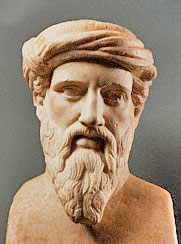
Pythagoras. The Pyramids at Giza were aligned to each
other using the bases as the "Pythagorean right-angle."
|
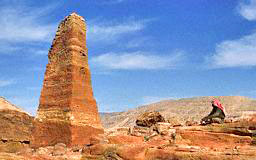
Obelisk
depicting Dushara, at Petra today.
|
MOUNT MORIAH, THE
TEMPLE MOUNT
|
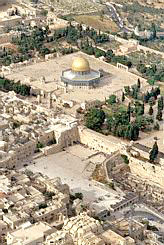
Dome of
the Rock, on Temple Mount
. |
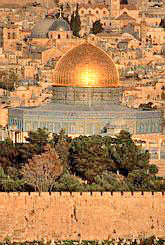
Dome of
the Rock. Calif Abdal Malik imported the "rock" which is
enshrined, from Baalbek. |
|
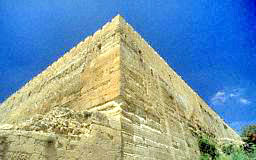
Bedrock
Foundations |
THE ANUNNAKI AND THE
30TH PARALLEL
|
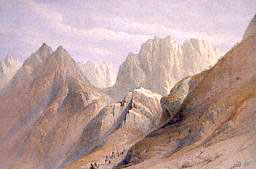
Watercolor of Mount Sinai; the final beacon for the
Landing Grid of the Anunnaki. Which with Jerusalem,
Baalbeck and Giza was complete, and all on the Thirtieth
Parallel
.
|

Persepolis, Iran today; also a great city of antiquity
and also built on the Thirtieth Parallel.
|
|
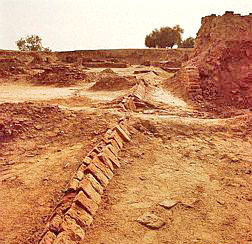
At
present Harappa is being researched by archaeologists,
who have found a buried city of antiquity, older than
Egyptian ancient cities and yet more advanced in water
ducts. Harappa was a sacred city of the Indus Valley
Civilization; the Indus Valley had been alloted to
Ishtar when the Earth was divided by the Anunnaki. |
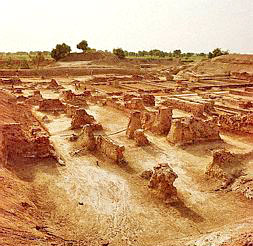
HARAPPA,
Pakistan today, it also lies on the Thirtieth Parallel
.
|
|
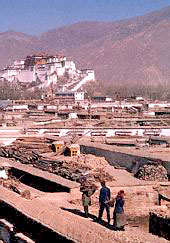 |
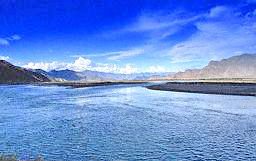
Lhasa in
Tibet, where Buddhism was born, also lies on the
Thirtieth Parallel. Lhasa River at right above, Lhasa
|
"The Ugaritic texts
invariably employed the phrase "penetrate the Shad of El"
when
describing the coming of other gods unto the presence of El "within
his seven chambers." This implied that these chambers were inside
the mountain - as were the chambers inside the artificial mountain
of the Great Pyramid. Historians of the first Christian centuries
reported that the people who dwelled in the Sinai and its bordering
areas at Palestine and North Arabia worshipped the god Dushara (Lord
of the Mountains) and his spouse Allat, "Mother of the Gods." They
were of course the male El and the female Elat, his spouse
Ashera.
The secret object of Dushara was, fortunately, depicted on a coin
struck by the Roman governor of those provinces. Curiously, it
resembles the enigmatic chambers within the Great Pyramid - an
inclined stairway ("Ascending Gallery") leading to a chamber between
massive stones ("the King’s Chamber"). Above it, a series of stones
re-create the pyramid’s "relieving chambers."
"Since the
Ascending Passages of the Great Pyramid - which are
unique to it - were plugged tight when Al Mamoon’s men broke into
it, the question is: Who, in antiquity, did know, and emulated, the
inner construction within the pyramid? The answer can only be: the
architects and builders of the Great Pyramid, who possessed such
knowledge. Only they could duplicate such construction elsewhere -
at Baalbek or within the mountain of El.
"And so it was, that although the
Mount of the Exodus was elsewhere,
in the northern half of the peninsula, the people of the area
transmitted from generation to generation the recollection of sacred
mountains among the peninsula’s southern peaks. They were the
mountains that, by their sheer height and location, and by virtue of
the instruments installed within them, served as beacons for the
"Riders of the Clouds."
"....When
the Anunnaki had landed on Earth and proceeded to
establish their facilities and Spaceport in Mesopotamia,
Mission
Control Center was at Nippur, "The Place of the Crossing." Its
"sacred" or Restricted Precinct was under the absolute control of
Enlil, it was called the KI.UR ("Earth City"). In its midst, atop an
artificial raised platform, was the DUR.AN.KI - "The Bond of Heaven
and Earth." It was, the Sumerian texts related, a "heavenward tall
pillar reaching to the sky." Firmly set upon the "platform which
cannot be overturned," this pillar was used by Enlil "to pronounce
the word" heavenward.
"....A Mission Control Center, similar to the one that had served
the landing path in pre-Diluvian Mesopotamia, had to be established
for the Spaceport in the Sinai. Where?
"Our answer is in
Jerusalem.
"Hallowed to Jew, Christian and Muslim alike, its very
atmosphere
charged with some inexplicably unearthly mystery, it had been a
sacred city even before King David established her as his capital
and Solomon built there the Lord’s Abode. When the Patriarch
Abraham
reached its gates, it was already a well-established center to "El
the Supreme, the Righteous One of Heaven and Earth." Its earliest
known name was Ur-Shalem - "City of the Completed Cycle" - a name
which suggests an association with orbital matters, or with the God
of Orbits. As to who Shalem might have been, scholars have offered
various theories, some of them (per Benjamin Mazar in "Jerusalem
before the David Kingship") name Enlil’s grandson Shamash; others
prefer Enlil’s son Ninib. In all theories, however, the
association
of Jerusalem’s roots with the Mesopotamian pantheon is undisputed.
"From its beginnings, Jerusalem encompassed
three mountain peaks;
from north to south, they were Mount Zephim, Mount Moriah and
Mount
Zion. Their names bespoke their functions: The northernmost was the
"Mount of Observers" (it is now called in English Mount Scopus); the
middle one was the "Mount of Directing"; the southernmost was the
"Mount of the Signal." They are still so called in spite of the
passage of millennia.
"....Of the three Mounts of Jerusalem, that of
Moriah has been the
most sacred....
"....The large horizontal platform atop Mount Moriah -
reminiscent
in layout of the one at Baalbek, though much smaller - has been
called "The Temple Mount," for it had served as the site of the
Jewish Temple of Jerusalem. It is now occupied by several Muslim
shrines, the most renowned of which is the Dome of the Rock. The
Dome was carried off by the Caliph Abd al-Malik (seventh century
A.D.) from Baalbek....
"....Muslims believe that it was from the
Sacred Rock that their
prophet Muhammed was taken aloft to visit Heaven.... by the angel
Gabriel from Mecca to Jerusalem, with a stopover at
Mount Sinai, then he was taken aloft by the angel, ascending
heavenward via a "Ladder of Light." Passing through the Seven
Heavens.... after receiving divine instructions (from God).... He
was returned the same way, riding the angel’s winged horse.
"....We do know, however, that the
First Temple was built by King
Solomon upon Mount Moriah at an exact spot and following precise
instructions provided by the Lord. The Holy-of-Hollies was built
upon the Sacred Rock: its innermost chamber, completely gilded, was
taken up by two large Cherubim (winged Sphinx-like beings) also made
of gold, their wings touching the walls and each other’s, between
them was placed the Ark of the Testament, from within which the
Lord
Addressed Moses in the desert. Completely insulated from the
outside, the gold covered Holy-of-Hollies was called in the
Old
Testament the Dvir - literally, "The Speaker."
"The suggestion that
Jerusalem was a "divine" communication center,
a place where a "Stone of Splendor" was secreted, and from which the
Word or Voice of the Lord beamed far and wide, is not as
preposterous as it may sound.... was not at all alien to the Old
Testament. In fact, the possession by the Lord of such a capability,
and the selection of Jerusalem as the communication center, were
considered to the attestations of Yahweh’s and Jerusalem’s
supremacy. "I shall answer the Heavens, and they shall respond to
Earth...."
"....Ba’al, the Lord of the facilities at
Baalbek, had boasted that
his voice could be heard at Kadesh, the gateway city to the Precinct
of the gods in the "Wilderness" of central Sinai....
"....The capabilities acquired by Ba’al when he
installed the "Stones
of Splendor" at
Baalbek were described in the
Ugaritic texts as the ability to put "one lip to Earth, one lip to Heaven." The
symbol
for this communication devices , as we have seen, were
the doves.
Both symbolism and terminology are incorporated in the verses of
Psalm 68, which describe the flying arrival of the Lord....
"....With the restoration of the
Temple at Jerusalem, the Prophets
promised, "the word of Yahweh from Jerusalem shall issue."
Jerusalem
would be re-established as a world center, sought by all the
nations. Conveying the Lord’s promise, Isaiah reassured the people
that not only the "probing stone" but also the "measuring" functions
would be restored.
"....To have served as a Mission Control Center,
Jerusalem - as Nippur - had to be located on the long central line bisecting the
Landing Corridor. Its hallowed tradition affirm such a position, and
the evidence suggests that it was that sacred rock which marked the
precise geodesic center.
"....The Prophet Ezequiel referred to the people of Israel as
"residing upon the Navel of the Earth." The term as we have seen,
meant that Jerusalem was a focal communication center, from which
"cords" were drawn to other anchor points of the Landing Grid. It
was thus no coincidence that the Hebrew word for the sacred rock was
Eben Sheti’yah - a term which Jewish sages held to have meant "stone
from which the world was woven."
"....But as suggestive as all these terms and legends are, the
decisive question is this: did Jerusalem in fact lie on the central
line which bisected the Landing Corridor, focused on Ararat and
outlined by the Giza pyramids and Mount Umm Shumar?
"The decisive answer is: Yes. Jerusalem lies precisely on that line!
"As was the case with
the pyramids of Giza, so do we discover in the case of the Divine
Grid more and more amazing alignments and triangulations.
Jerusalem, we find, also lies precisely where the Baalbek-Katherine
line intersects the flight path’s central line based on Ararat. Heliopolis, we find is precisely equidistant from
Jerusalem as Mount
Umm Shumar.
And the diagonals drawn from Jerusalem to Heliopolis and to
Umm Shumar form an accurate 45 degree right angle.
"These links between
Jerusalem,
Baalbek (The Crest of Zaphon) and
Giza (Memphis) were known, and hailed, in biblical times.... The
Book of Jubilees held,
The Garden of Eternity, the most sacred,
is the dwelling of the Lord;
And Mount Sinai, in the center of the desert;
And Mount Zion, the center of the Navel of the Earth.
These three were created as holy places,
FACING EACH OTHER.
"Somewhere along the "Line of Jerusalem" the central flight line
that was anchored on Mount Ararat, the Spaceport itself had to be
located. There, too, the final beacon had to be located: "Mount
Sinai, in the center of the desert."
"It is here, we suggest, that the dividing line which we now call
the Thirtieth Parallel (north) had come into play.
"We know from Sumerian astronomical texts that the skies enveloping
Earth were so divided as to separate the northern "way" (allotted to
Enlil) from the southern "way" (allotted to
Ea) with a wide central
band considered the "Way of Anu." It is only natural to assume that
a dividing line between the two rival brothers should also have been
established after the Deluge, when the settled Earth was divided
into the Four Regions, and that, as in pre-Diluvial times, the
Thirtieth Parallel (north and south) served as demarcation lines.
"Was it mere coincidence, or a deliberate compromise between the two
brothers and their feuding descendants, that in each of the three
regions given to Mankind, the sacred city was located on the
Thirtieth Parallel?
"The Sumerian texts state that "When Kingship was lowered from
Heaven" after the Deluge, "Kingship was at Eridu."
Eridu was
situated astride the Thirtieth Parallel as close to it as the marshy
waters of the Persian Gulf had permitted....
"....In the
Second Region.... Heliopolis for ever remained the
sacred city.... was located astride the Thirtieth Parallel, as close
to it as the Nile’s delta permitted!
"When the Third Region, the
Indus Valley Civilization, followed, its
secular center was on the shores of the Indian Ocean, but its sacred
city - Harappa - was hundreds of miles away to the north - right on
the Thirtieth Parallel.
"The imperative of the northern Thirtieth Parallel appears to have
continued in the millennia that followed. Circa 600 B.C. the Persian
kings augmented the royal capital with a city "Sacred unto all
Nations." The place selected for its construction was a remote and
uninhabited site. There, literally in the middle of nowhere, a great
horizontal platform was laid out. Upon it, palaces with magnificent
staircases and many auxiliary shrines and structures were erected -
all honoring the God of the Winged Globe. The Greeks called the
place Persepolis ("City of the Persians").... And it was located
astride the Thirtieth Parallel.
"No one knows for sure when
Lhasa in Tibet - the sacred city of
Buddhism - was founded. But it is a fact that Lhasa too - as
Eridu,
Heliopolis, Harappa and Persepolis were - was situated
on the same
Thirtieth Parallel.
"The sanctity of the Thirtieth Parallel must be traced back to the
origins of the Sacred Grid, when the divine measurers determined the
location of the pyramids of Giza also on the Thirtieth Parallel.
Could the gods have given up this "sanctity" or neutrality of the
Thirtieth Parallel when it came to their most vital installation -
the Spaceport - in their own Fourth Region, in the Sinai Peninsula?
"It is there that we ought to seek a final clue from the remaining
enigma of Giza - its Great Sphinx. Its body is that of a crouching
lion, its head of a man wearing the royal headdress. When and by
whom was it erected? And to what purpose? Whose image does it bear?
And why is it where it is, alone, and nowhere else?
"The questions have been many, the answers very few. But one thing
is certain: it gazes precisely eastward, along the Thirtieth
Parallel.
"This precise alignment and gaze eastward along the
Divine Parallel
were emphasized in antiquity by a series of structures that extended
from in front of the Sphinx eastward precisely along an east-west
axis.
"When Napoleon and his men saw the Sphinx at the turn of the
eighteenth century, only its head and shoulders protruded above the
desert sands; it was in that state that the Sphinx was depicted and
known for the better part of the century that followed. It took
repeated and systematic excavations to reveal its full colossal size
(240 feet long, 65 feet high) and shape and to confirm what ancient
historians had written: that it was a single piece of sculpture,
carved by some giant hand out of the natural rock. It was non other
than Capt. Caviglia, whom Col. Vyse forced out of
Giza, who had
uncovered during 1816-1818 not only a good part of the body and
extended paws of the Sphinx, but also the temples, sanctuaries,
altars and stelas that were erected in front of it.
Among several features uncovered, "there, a structure whose function
was to support two columns was so situated that the eastward gaze of
the Sphinx passed precisely between the two columns."
Romans and Greeks, continued the tradition of the
Pharaohs:
"....to visit and pay homage to the Sphinx, leaving behind
appropriate inscriptions. They affirmed the belief, which continued
into Arab times, that the Sphinx was the work of the gods
themselves; it was deemed to be the harbinger of a future messianic
era of peace. An inscription by the notorious emperor Nero called
the Sphinx "Armachis," Overseer and Savior."
".... As the "Inventory Stela" attests,
the Sphinx had already stood
at Giza in the time of Khufu, a predecessor of
Chefra. Like several
Pharaohs after him, so did Khufu take credit for removing the sand
that encroached upon the Sphinx. From this it must be deduced that
the Sphinx was already an olden monument in Khufu’s time. What
earlier Pharaoh, then, had erected it, implanting upon it his own
image?
"The answer is that the image is not of any Pharaoh, but of a god,
and that in all probability, the gods and not a mortal king had
erected the Sphinx.
Among other inscriptions,
Mr. Sitchin mentions:
"....In the
Inventory Stela, Khufu called the Sphinx "Guardian of
the Aeter," who guides the Winds with his gaze. It was, as he
clearly wrote, the image of a god:
This figure of the god
will exist to eternity;
Always having its face
watching towards the east.
"In his inscription,
Khufu mentions that a very old sycamore tree
that grew near the Sphinx was damaged "When the
Lord of Heaven
descended upon the Place of Hor-em-Akhet," "the Falcon-god of the
Horizon." This indeed was the most frequent name of the Sphinx in
Pharaonic inscriptions; his other epithets being Ruti ("The Lion")
and Hul (meaning, perhaps, "The Eternal").
Although excavators, like
Caviglia and Perring, have tried to find
"secret chambers" under the Sphinx, none has been found.
"Even more responsible researchers, such as Auguste Mariette in
1853, shared the general opinion that there is a hidden chamber
concealed in or under the Sphinx..... The searchers have surmised
that if the Sphinx itself could have been almost hidden from sight
by the encroaching sands, so much so could the sands of desert and
time completely hide any substructure.
"The most ancient
inscriptions seem to suggest that there indeed existed not one, but
two secret chambers under the Sphinx - perhaps reachable through an
entrance hidden under the paws of the monument. A hymn from the time
of the Eighteenth Dynasty, moreover, reveals that the two "caverns"
under the Sphinx enabled it to serve as communications center!
"The God Amen, the inscription said, assuming the functions of the
heavenly Hor-Akhti, attained "perception in his heart, command in
his lips ... when he enters the two caverns which are under his (the
Sphinx’s) feet." Then,
A message is sent from heaven;
It is heard in Heliopolis,
and it is repeated in Memphis by the Fair of Face.
It is composed in a dispatch by the writing of Thoth,
with regard to the city of Amen (Thebes) ...
The matter is answered in Thebes,
A statement is issued ... a message is sent.
The gods are acting according to command.
"In the days of the Pharaohs it was believed that
the Sphinx -
though sculptured out of stone - could somehow hear and speak....
"....Many unusual "Ear Tablets" and depictions of the
Twin Doves - a
symbol associated with oracle sites - were found in the temples
surrounding the Sphinx. Like the ancient inscriptions, they also
attest to the belief that somehow the Sphinx could transmit Divine
Messages. Although the efforts to dig under the Sphinx have not been
successful, one cannot rule out the possibility that the
subterranean chambers which the gods had entered with "command in
their lips" would still be found.
"It is clear from numerous funerary texts that
the Sphinx was
considered to have been the "Sacred Guide" who guided the deceased
from "yesterday" to "tomorrow...."
"...A stela erected by one
Pa-Ra-Emheb, who directed works of
restoration at the site of the Sphinx in Pharaonic times, contains
telltale verses in adoration of the Sphinx; their similarity to
biblical Psalms is truly tantalizing. The inscriptions mention the
extensions of cords "for the plan," the making of "secret things" in
the subterranean realm; they speak of the "crossing of the sky" in a
Celestial Barge, and of a "protected place" in the "sacred desert."
It even employs the term Sheti.ta to denote the "Place of the Hidden
Name" in the Sacred Desert....
"....To the Hebrew Prophets, the
Sheti - the central Flight Line
passing through Jerusalem - was the Divine Line, the direction to
watch: "within it did the Lord come from sacred Sinai."
"But to the Egyptians, as the above inscription declared,
Sheti.ta
was the "Place of the Hidden Name." It was in the "Sacred Desert" -
which is exactly what the biblical name "Desert of Kadesh" has
meant. And to it, the "cords of the plan" were extended from the
Sphinx. There, Paraemheb had seen the King of the Gods ascend by
day, the words are almost identical to those of Gilgamesh, arriving
to Mount Mashu, "where daily the Shems he watched, as they depart
and come in ... watched over Shamash as he ascends and descends."
"It was the Protected Place, the Place of Ascent. Those who were to
reach it were guided there by the Sphinx; for its gaze led eastward,
exactly along the Thirtieth Parallel.
"It was there the two lines intersected, we suggest - where the
Line
of Jerusalem intersected the Thirtieth Parallel that the Gates of
Heaven and Earth were located; the Spaceport of the gods.
At this point, Mr. Sitchin explains a chart which appears on his
book, the sacred cities, and alignments:
"....As we fill in our chart, the
masterful Grid conceived by the
Anunnaki unfolds before our very eyes; and we are truly
astounded by its precision, simple beauty, and the artful
combination of basic geometry with the landmarks provided by nature.
"....Were other sacred cities and oracle sites in
Egypt, such as the
great Thebes and Edfu, located where they were at a king’s whim, at
an attractive bend of the Nile - or where alignments of the Grid had
dictated?
"Indeed, were we to study all these sites, all of Earth would
probably be encompassed. But was that not what Ba’al had already
known when he established his clandestine facilities at Baalbek? For
his aim, we recall, was to communicate with and dominate, not just
the nearby lands, but all of Earth.
"This the biblical Lord too must have known, for when
Job sought to
unravel the "wonders of El," the Lord "answered him from
within the
whirlpool," and countered questions with questions:
Let me ask thee, and answer thou me;
Where wast thou,
when the Earth’s foundation I laid out?
Say, if thou knowest science:
Who hath measured it (the Earth), that it be known?
Or who hath streched a cord upon it?
By what were its platforms wrought?
Who hath cast its Stone of Corners?
"Then the Lord
answered His own questions. All these acts of Earth
measuring, the laying out of platforms, the setting up of the Stone
of Corners were done, He said:
When the morning stars rejoiced together
And all the sons of the gods shouted for joy.
"Man as wise as he might have been, had no hand in all that.
Baalbek,
the Pyramids, the Spaceport - all were meant for the gods alone.
But Man, ever searching for Immortality, has never ceased to follow
the gaze of the Sphinx.
|
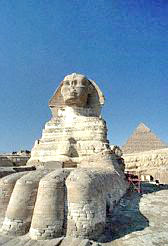
THE
SPHINX... Body of a crouching lion, the head of a man
wearing the Royal Headdress gazes eastward along the
30th Parallel! Her gaze is toward where Space Mission
Control was, Jerusalem. |
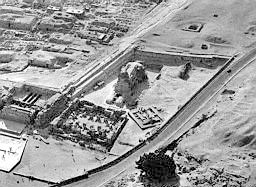
Caviglia
discovered a complex in 1816-18 which had been erected
in front of the Sphinx, where two columns stood and from
which in between them the gaze of the Sphinx would stare
toward East
|
|

Nero, wrote
of the Sphinx "Armachis" = Overseer and Savior.
|
|
 |

Thebes,
another ancient city which was built on the 30th
Parallel
.
|
|
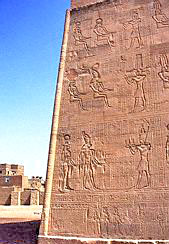
. |
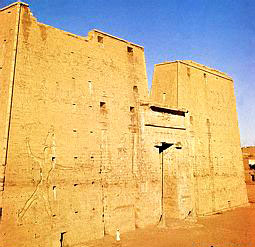
Temple of
Horus at Edfu, yet another city built on the 30th
Parallel. |
Return
|



